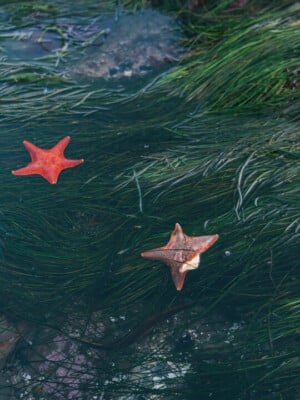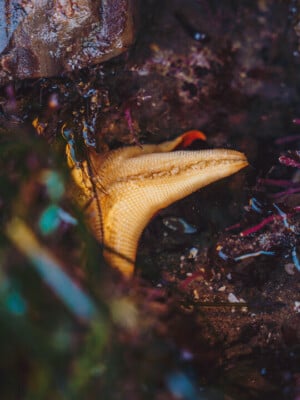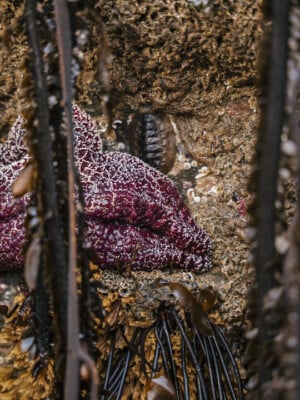When the tide retreats, the coastlines of Santa Cruz County reveal a hidden universe. Rocky coves and wave-carved shelves transform into natural aquariums filled with dazzling creatures, from tiny jeweled nudibranchs to the elusive Pacific octopus. While you can explore tide pools year-round, the extreme low tides during winter king tides offer an especially dramatic window into this world. Whether you’re wandering the family-friendly pools at Natural Bridges or scrambling over the rugged rocks at Wilder Ranch, tide pooling in Santa Cruz is a chance to see the ocean’s wonders up close.

Nudibranchs
These delicate sea slugs look like they’ve come straight out of a fantasy novel, wearing flamboyant colors and intricate frills. Some glow with electric blues or fiery oranges, while others display spotted or striped patterns that rival stained glass. Nudibranchs are a rare treat to spot, often blending in with sponges and algae. Keep an eye out at Pleasure Point for the best chance to see them. Often as small as your pinky nail, they can be very hard to spot, so move slowly and look carefully! They prefer calmer, more harbored pools that don’t have turbulent wave action, and they can cling to the rocky pools, which provide the perfect camouflage for these tiny jewels of the sea.



Starfish
Now more often called sea stars, these iconic tide pool creatures cling tightly to the rocks with hundreds of tiny tube feet. Their classic five-armed shape makes them easy to recognize, but Santa Cruz tide pools sometimes reveal rarer species with extra arms. Sea stars are most often spotted along the rocky ledges of Wilder Ranch and Scott Creek Beach, where they feed on mussels and barnacles exposed by the tide. Watching them slowly glide across the rocks is like seeing time in motion.

Anemones
Green sea anemones look like tide pool gardens, their tentacles waving like underwater flowers. These stinging arms capture tiny fish and plankton, though they’re harmless to people who gently touch them with a fingertip. On sunny days, anemones glow neon green thanks to algae living inside their tissues. Here in Santa Cruz, tidepoolers can discover a huge array of differently colored sea anemones from deep blues and greens to even reds! They’re easy to find at nearly every tide pool in Santa Cruz, but the tide pools at Pleasure Point and the base of Natural Bridges are especially abundant. At low tide, watch them close up into squishy little blobs, waiting for the ocean’s return.

Kelp Crabs and Hermit Crabs
Santa Cruz’s tide pools are bustling with busy crabs of every size. Kelp crabs, with their long legs and sharp pincers, often hide beneath mats of seaweed, looking like armored warriors ready for battle. Hermit crabs, on the other hand, steal the show with their borrowed shells, scuttling about in a comical parade of shapes and sizes. Children love spotting these crustaceans in the calmer pools of nearly every rocky beach area in Santa Cruz County, where they’re easy to see darting between rocks and shells.

Octopus
The ultimate tide pool treasure, a Pacific octopus is a rare but unforgettable sight. Masters of disguise, octopuses can change both color and texture to melt into their surroundings. With their curious, intelligent eyes and eight quick arms, they explore tide pools in search of crabs, clams, and fish. While sightings are uncommon, patient explorers may be rewarded at Pleasure Point or along the more remote coves near Davenport. Spotting one feels like a secret gift from the sea, a reminder of just how wild and mysterious the intertidal world can be.

Tips for Exploring Tide Pools Responsibly
To keep these ecosystems thriving, it’s important to visit tide pools with care:
- Check the tides: Plan your visit during the lowest tides of the month, often around king tide weekends in winter, to reveal the widest range of pools. Every day the tides are different so be sure to plan ahead to find the lowest tides and best times to visit.
- Wear sturdy shoes: The rocks are slippery and uneven, so closed-toed shoes with good grip will keep you safe. Waterproof shoes can also be very helpful, but be very careful where you step to ensure you aren’t stepping on any of our tidal friends.
- Step lightly: Avoid crushing barnacles, shells, and fragile creatures underfoot by stepping on bare rock when possible. Assume everything underfoot has a potential life form hiding there and step carefully.
- Look, don’t collect: Tide pool creatures are protected. Admire them in place rather than removing them from their homes. Look with your eyes and leave the creatures you discover in their homes.
- Leave no trace: Pack out any trash, and remember that even a small piece of seaweed is part of the habitat. Leave everything as you found it and try not to disturb any of these delicate, precious habitats.
By exploring with respect, you help protect these tidal treasures so future visitors can experience the same magic.


